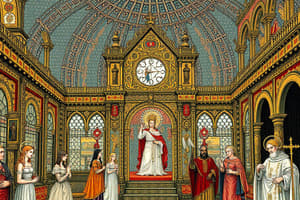Podcast
Questions and Answers
What was the role of Byzantine emperors within the church?
What was the role of Byzantine emperors within the church?
- They abandoned the church following Iconoclasm.
- They had no influence over ecclesiastical matters.
- They treated the church as a department of state. (correct)
- They were primarily religious leaders equivalent to popes.
What sparked riots throughout the Byzantine Empire during Emperor Leo III's reign?
What sparked riots throughout the Byzantine Empire during Emperor Leo III's reign?
- Formation of new religious sects.
- The endorsement of Arian views.
- The policy of iconoclasm. (correct)
- Imposition of new tax laws.
Which theological view was ultimately endorsed at the Council of Nicaea?
Which theological view was ultimately endorsed at the Council of Nicaea?
- The concept of the Holy Trinity as a single entity.
- The view that Jesus was both human and divine. (correct)
- The view that Jesus was solely divine.
- Arianism, which viewed Jesus as a mortal.
What influence did Greek philosophy have on Byzantine theology?
What influence did Greek philosophy have on Byzantine theology?
What characterized the relationship between the Byzantine laity and ecclesiastical authorities?
What characterized the relationship between the Byzantine laity and ecclesiastical authorities?
What was the primary focus of Byzantine monasteries under St. Basil's rule?
What was the primary focus of Byzantine monasteries under St. Basil's rule?
How did Byzantine monks and nuns contribute to their communities?
How did Byzantine monks and nuns contribute to their communities?
How did Byzantine Christianity differ from earlier Mediterranean religious traditions?
How did Byzantine Christianity differ from earlier Mediterranean religious traditions?
What was a significant outcome of the ascetic movements in Byzantine monasticism?
What was a significant outcome of the ascetic movements in Byzantine monasticism?
What effect did the extreme dedication of ascetics have on Byzantine laity?
What effect did the extreme dedication of ascetics have on Byzantine laity?
Flashcards
Caesaropapism
Caesaropapism
The close alignment of Byzantine Christianity and the imperial government.
Council of Nicaea
Council of Nicaea
An ecumenical council convened in 325 C.E. by Emperor Constantine to address Arian beliefs.
Iconoclasm
Iconoclasm
The banning of religious images, initiated by Emperor Leo III.
Asceticism
Asceticism
Signup and view all the flashcards
St. Basil of Caesarea
St. Basil of Caesarea
Signup and view all the flashcards
Mystical Union
Mystical Union
Signup and view all the flashcards
Monastic Social Services
Monastic Social Services
Signup and view all the flashcards
Study Notes
Byzantine Church and State
- Close relationship between Byzantine Christianity and imperial government known as caesaropapism.
- From Constantine's reign, emperors actively participated in religious matters.
- In 325 C.E., Constantine organized the Council of Nicaea addressing Arian beliefs about the nature of Jesus.
- Constantine initially favored Arianism but later supported orthodox views of Jesus as both human and divine.
- Byzantine emperors treated the church as a state department, appointing patriarchs and directing church sermons to align with imperial policies.
- Iconoclasm initiated by Emperor Leo III (717–741 C.E.) caused widespread riots as it opposed the veneration of religious images.
Greek Philosophy and Byzantine Theology
- Byzantine Christianity was heavily influenced by ancient Greek philosophy.
- Theologians analyzed key religious questions using concepts from Greco-Roman philosophy.
- A patriarchal school in Constantinople focused on advanced theological instruction for clergy.
- Byzantine cultural and religious traditions built on a foundation of Greco-Roman culture.
Monasticism and Society
- High church officials, including emperors and patriarchs, often neglected the lay populace's concerns.
- Byzantine laity were less interested in intricate theology and resented iconoclastic policies that disrupted worship.
- Local monasteries served as primary sources of religious inspiration for the laity.
Asceticism
- Byzantine monasticism emerged from the desire for extreme holiness and self-denial among devout individuals.
- Inspired by early Christian ascetics, individuals demonstrated dedication through extreme practices, like living atop pillars.
- Such ascetics attracted followers, forming early monastic communities.
- St. Basil of Caesarea (329-379 C.E.) emphasized communal living, obedience, and a focus on work and prayer in monastic life.
Byzantine Monasticism
- Distinguishing characteristic of Byzantine monasteries: they did not become primary centers of education and scholarship unlike western counterparts.
- Renowned for piety, Basilian monks pursued mystical union with God through prayer and meditation.
- Some monks led lives of strict asceticism in remote areas, appealing to the laity's spirituality.
- Monks and nuns offered social services, providing counsel and organizing relief for communities in need, fostering support from the Byzantine populace.
Studying That Suits You
Use AI to generate personalized quizzes and flashcards to suit your learning preferences.




